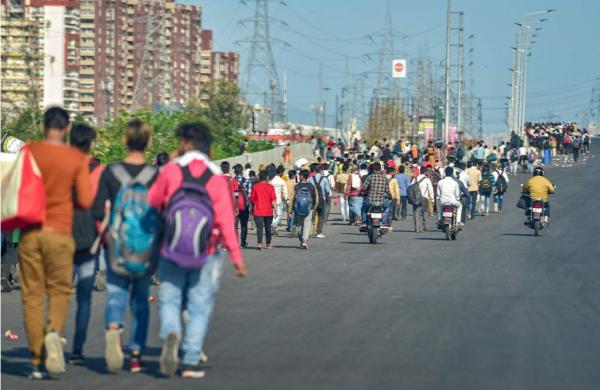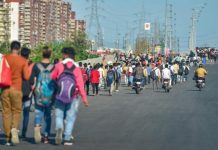This article is written by S A Rishikesh, from Institute of Legal Studies, Shri Ramswaroop Memorial University, Lucknow. This article examines the reason for the failure of the Illegal Migrants (Determination by Tribunals) Act, 1983 and the final words of the Supreme Court on it.
Introduction
Migration is a global phenomenon, people move to other countries for a better life, peace, economic security, etc. Each country tries its best to control migration and prevent illegal immigration but many are unsuccessful in their attempts. Illegal immigration has enormous demographic and social implications, capable of creating tensions and conflict between the immigrants and the natives. Efforts to prevent and control illegal immigration in India have been highly inadequate, particularly the conditions of northeastern states is worrisome. These states have been a victim of illegal immigration from across the border in Bangladesh. Bangladesh is landlocked from three sides by India. It shares a 4096-kilometre international border with India. The Indian states of West Bengal, Meghalaya, Tripura, Mizoram and Assam share an international border with Bangladesh. Assam, a northeastern state of India, shares 267 kilometres of the international border. Large scale illegal immigration from Bangladesh is a major issue in Assam which has led to many ethnic conflicts in the past.
An overview of the immigration scenario in India
The immigration started from the British period only. Britishers promoted the immigration of people from Bengal to the fertile river basin of Brahmaputra in Assam to generate more revenue. 1947 was an important year in this aspect when two countries came into existence, India and Pakistan. It led to intense violence between Hindus and Muslims and the trend of migration of people from East Pakistan into India in search of economic opportunities. It was clearly seen in the census when Assam registered an overall population growth of around 35 to 36 percent way above the national average indicating the rise of the population through migration.
The 1971 war between East and West Pakistan, which gave birth to Bangladesh, triggered another massive immigration of people from Bangladesh to India. Estimates suggest close to 10 million people entered India. To make the matter even worse, people deported from Assam in the 1960s re-entered India. Illegal immigration continued even after this and soon acquired the centre stage of Assam politics.
Government’s response
Witnessing large-scale protests from the Assamese people and the threat to national security by illegal immigration, forced the government to take some harsh steps to identify and deport the infiltrators. In June 1960, the Union government launched Prevention of Infiltration in India Pakistani Nationals (PIP). The aim of this scheme was to deny entry to any new immigrant from East Pakistan while keeping a watch on existing settlements of migrants and deporting any new migrant. After the emergence of Bangladesh, the scheme was renamed as the Prevention of Infiltration of Foreigners (PIF). The scheme was not implemented continuously but from time to time. The scheme could not deliver the kinds of results expected from it. It also drew a lot of international criticism because of the vast powers given to the police officials.
In response to the criticism, the Union government created the Foreigner’s Tribunals in 1964. These tribunals had the power to take up the case of a person and decide if he is a foreigner or not. It was created for the people who were served ‘Quit India’ notice by the police officials. Such people could apply to these tribunals and get the chance of a fair hearing. This also proved to be ineffective like the PIF scheme, because the whole process was causing excessive delays in identifying and depositing the illegal migrants.
These failures led to anti-foreigners agitation in the state of Assam in the late 1970s and early 1980s. Continuous agitations and protests forced the union government to take extraordinary steps.
The Illegal Migrants (Determination by Tribunals) Act, 1983
The Indira Gandhi government enacted The Illegal Migrants (Determination by Tribunals) Act, 1983. The Act was applicable to the whole of India but came into force only in the state of Assam on October 15, 1983. The other states of India were governed by the Foreigners Act 1946. The objective of the Illegal Migrants Act was similar to the previous government’s attempt- expulsion of foreigners and protection of Indian citizens.
Section 3(c) of the Act defined illegal migrants. According to the Section, any person is an illegal migrant if he fulfils the following conditions:
- Has entered India after 25th March 1971.
- The person is a foreigner.
- Has entered India without a valid passport and other valid legal documentation.
Section 2 of the Act contained a list of individuals on whom the Act was not applicable:
- Any individual who has been deported from India before the commencement of this Act or any such individual who has been deported under any other law in force;
- Any individual who was detected to be a foreigner during his entry from any of the international borders of India;
- Any foreigner who entered India with a valid Passport and Visa but is residing in India even after the expiration of his visa.
This Act paved the way for the establishment of judicial tribunals in Assam, for determination if a person is a foreigner or Indian citizen. Unlike the Foreigners Act 1946, the burden of proof here was on the government. Through the establishment of tribunals, the government gave a fair chance to the accused to prove his identity. The person, if not satisfied with the decision of the Tribunal, had an option to appeal to the Appellate Tribunal.
Illegal Migrants (Determination) Tribunals
The Act clearly mentioned that the Central government could by notification establish as many Illegal Migrants (Determination) Tribunals as it may find necessary. Each Tribunal shall exercise its jurisdiction within its territorial limits. Each Tribunal should consist of a minimum of two members. The person appointed as a member of the Tribunal shall either be District Judge or Additional District Judge in a state.
Application to the Tribunal can be made in two ways:
- Against the order of the government declaring any person a foreigner and asking him to leave the country.
- By any other person accusing another to be an illegal migrant.
The Tribunal enjoyed the following powers:
- Summoning and enforcing the attendance of witnesses and examining them on oath;
- Discovery and production of any document;
- Reception of evidence on affidavits;
- Requisitioning of public records from any court or office;
- Issuing of any commission for the examination of witnesses.
To make this process effective it was necessary to dispose of matters quickly, therefore Section 13 of the Act stated that the reference made to the Tribunal must be inquired expeditiously and disposed of within a period of six months from the date of service.
Illegal Migrants (Determination) Appellate Tribunal
The Appellate Tribunal was also to be established on the directions of the central government and shall have a minimum of two members and a maximum of six members. To be eligible to be a member of that Appellate Tribunal, the person shall be the Judge of a High Court. An appeal could be made in the Appellate Tribunal within 30 days of the order of the Tribunal. After the passing of thirty days, if the Appellate Tribunal was satisfied with the cause of delay, the matter would be taken otherwise the decision of the Tribunal would be final.
Criticism
The Act was described as ‘toothless’ by the critics because it also failed to identify and deport illegal immigrants effectively. It was legislation more on paper than on the ground, it is evident as out of thirty tribunals provided in the original Act only sixteen were finally approved. And out of the sixteen, only five were functional by 1998.
One of the reasons why the Act failed was, it gave power to a third person to report illegal migrants against whom he had some information but this right was limited. The provision stated that both the person who is complaining and the accused against whom the complaint is lodged should reside under the same police station. The burden to prove the guilt was on the State. The State had to prove if that person is an illegal migrant, this was done to discourage non-serious cases but it turned out to be a mistake. Each time a person was reported under this Act they changed their location and became untraceable. Unlike the Foreigners Act, this Act did not give the power to state police to search and seizure.
Till July 2005, of the 1,12,791 cases referred to the tribunals, 88,770 cases were pending and only 12,846 were declared as illegal migrants, of which 1,547 could be deported or pushed back across the border into Bangladesh.
Sarbananda Sonowal v. Union Of India (2005)
Seeing the ineffectiveness of the IMDT Act there was a huge demand to repeal this Act and finally in the year 2000 Sarbananda Sonowal, resident of Assam, former President of All Assam Student Union and former Chairman of the North East Students Association, filed a writ petition under Article 32 of the Constitution of India by way of public interest litigation claiming that some of the provisions of Illegal Migrants (Determination by Tribunals) Act, 1983 ultra vires, therefore, the Foreigners Act 1946 and the rules made thereunder shall apply to the state of Assam. The respondents were the State of Assam and the Union of India.
On 18th July 2000, Shri Jatinder Bir Singh, Director, Ministry of Home Affairs filed a counter-affidavit on behalf of the Union of India which stated that a proposal to repeal the IMDT Act is already under consideration with the Government of India. The government also accepted that it is impossible to make a realistic estimate of the numbers of illegal immigrants from Bangladesh because of ethnic and linguistic similarities between the local population and the migrants.
On 28th August 2000 Assam filed a counter-affidavit stating that the state government of Assam is continuously writing to the Central Government and urging them to repeal the IMDT Act. The affidavit also mentioned that the state government believes that the IMDT Act is against the national interest because of the strict provisions of the Act, illegal migrants whose numbers are in lakhs in the State of Assam, are being unable to trace out and deport. The state government also called the Act discriminatory because it was implemented only in Assam and not in states like West Bengal, Tripura and Meghalaya which were facing a similar situation of illegal migrants.
On 8th August 2001, the Assam government requested the court to withdraw its earlier counter-affidavit filed on 28th August 2000, citing the reason that the affidavit did not reflect the correct position of law in the state. They also requested that the government should be allowed to file a new counter-affidavit. The new affidavit stated that the law was brought to save the Indian citizens from unnecessary harassment. The IMDT Act is constitutional, it is not arbitrary or discriminatory therefore the government is against the opinion of striking down or repealing the Act.
The 175th report of the Law Commission of India on Foreigners (Amendment) Bill, 2000 also dealt with the Assam issue. The report stated that the entry of illegal migrants is not only undesirable but also causes a great threat to the democratic structure and internal security of India especially in the Eastern part of the country and Jammu and Kashmir. The report also advocated for the repeal of the IMDT Act.
Three judges bench of Justice R.C. Lahoti, Justice G.P. Mathur and Justice P.K. Balasubramanyan acknowledged the plight of the people of Assam who were being reduced to a minority within their own state. In the judgement passed on July 12, 2005, the Court declared the Illegal Migrants (Determination by Tribunals) Act, 1983 unconstitutional and accordingly the Illegal Migrants (Determination by Tribunal) Rules, 1984 were struck down. All the cases that were pending before the Tribunals constituted under IMDT Act were transferred to the Tribunals constituted under the Foreigners (Tribunals) Orders, 1964 and all the cases were to be decided in the manner provided in the Foreigners Act and the rules made thereunder.
Conclusion
The country had two anti-immigration laws. One which was applied to the whole of India- the Foreigners Act, 1946 and the other which was applied only in the state of Assam- the Illegal Migrants (Determination by Tribunals) Act, 1983. By scrapping the IMDT Act the Apex Court removed the anomaly. Both the Acts had many differences, be it the burden of proof or the procedures to identify and report the illegal migrants. Removal of the IMDT Act has ensured that all the citizens of India are within one umbrella of law.
References
- https://legislative.gov.in/sites/default/files/A1983-39.pdf
- http://www.daji.org.in/images/NRC%20Assam%20poses%20risk%20of%20statelessness.pdf
- http://onlineedistrict.amtron.in/web/home-and-political-department/white-paper
- https://www.rediff.com/news/2005/jul/12act1.htm
- https://idsa.in/system/files/monograph/monograph56.pdf
Students of Lawsikho courses regularly produce writing assignments and work on practical exercises as a part of their coursework and develop themselves in real-life practical skills.
LawSikho has created a telegram group for exchanging legal knowledge, referrals, and various opportunities. You can click on this link and join:
https://t.me/joinchat/J_0YrBa4IBSHdpuTfQO_sA
Follow us on Instagram and subscribe to our YouTube channel for more amazing legal content.
 Serato DJ Crack 2025Serato DJ PRO Crack
Serato DJ Crack 2025Serato DJ PRO Crack










 Allow notifications
Allow notifications



